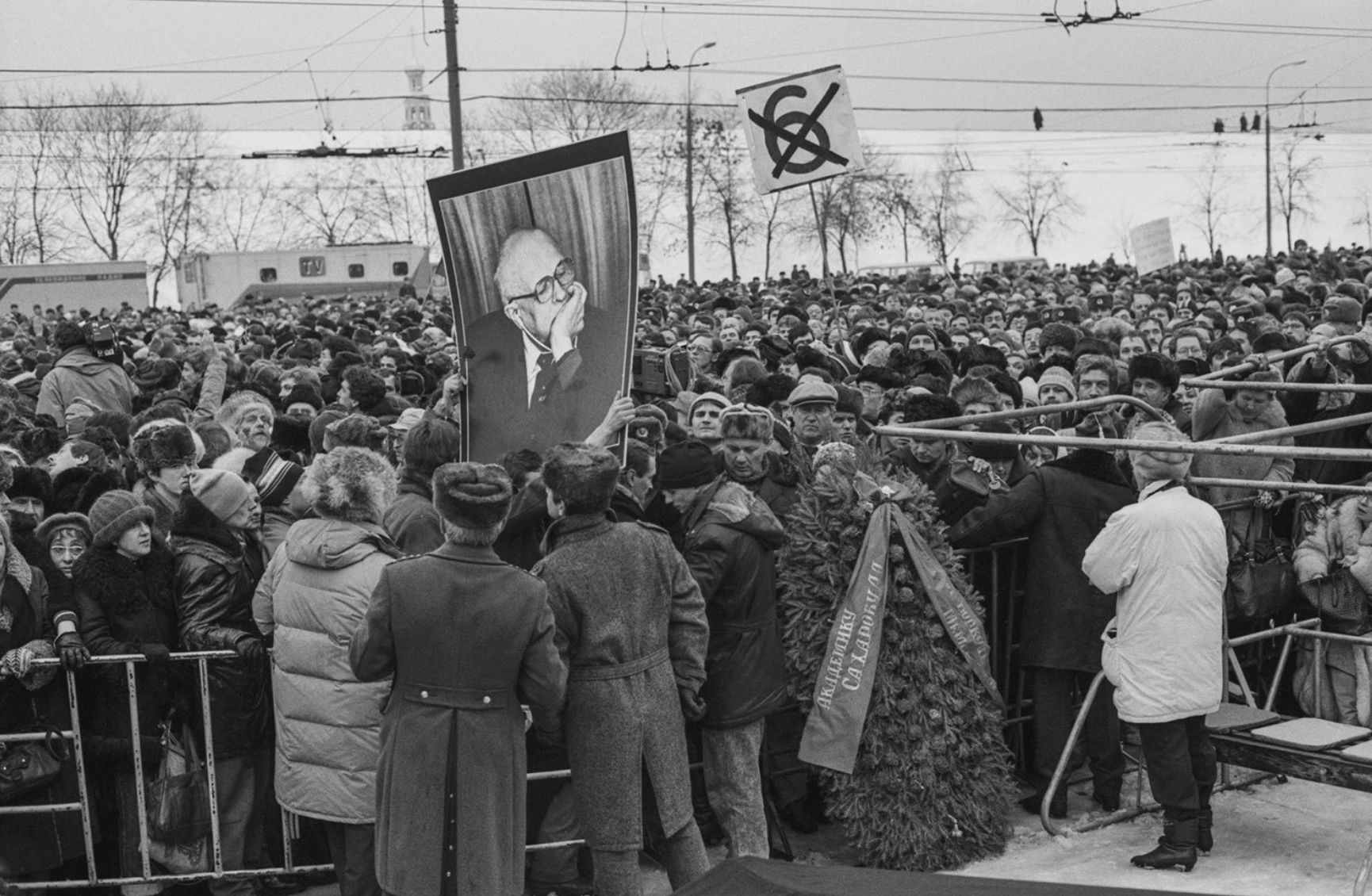Filed Under: Print > Journalism > Death and funeral of Andrei Sakharov
Death and funeral of Andrei Sakharov

In the late 1980s, renowned nuclear physicist turned Nobel Peace-prize winning political dissident Andrei Sakharov (1921-1989) experienced a dramatic reversal in his public image: once ostracized by the Soviet press, he now became a media darling. After his release from exile and return to Moscow in 1986, he became famous for his advocacy for reform, peace, and democracy. His election to the USSR Congress of People’s Deputies in spring 1989 and his vocal participation in the First Congress from 24 May to 9 June in that year made him one of the Soviet Union’s best-known and most respected public figures by the time he died in December.
A survey conducted by the political weekly Argumenty i fakty in October 1989 had ranked Sakharov as the most popular figure in the Soviet Union at that time. According to historian Archie Brown, the survey generated friction between Gorbachev and Vladislav Starkov (1940-2004), the paper’s editor. Unscientific though this particular survey might have been, later questionnaires confirmed Sakharov’s high standing in society. A poll conducted by the All-Union Center for the Study of Public Opinion (VTsIOM) in Moscow in 1990 asked respondents to name the Man of the Year: Gorbachev came in first, but Sakharov second, beating out future Russian President Boris Yeltsin (1931-2007). A poll conducted by the Levada Center in February 1990, which asked respondents to name the most moral person of the time, named Yeltsin first, Sakharov second, and Gorbachev only third.
Sakharov remained profoundly active and committed to transforming Soviet politics to the minute he died. He actively participated in the Second USSR Congress of People’s Deputies (12-24 December 1989). Around 9 PM on 12 December, after the long first day of the Congress, he went to his study to take a nap and asked his wife, Yelena Bonner (1923-2011), to wake him up at 11 PM. When she went to do so, she found him on the floor, dead. To his political detriment, Gorbachev did not announce his death at the Congress the next day, leaving the task to a lower-ranking colleague. He also did not call a day of mourning for the Congress, since this would have broken with Soviet protocol (three days of mourning for a state leader, one day for a Politburo member, as Gorbachev pointed out), but which would have resonated more with the mood of Moscow and the Soviet Union at large. Sakharov’s body was laid in wake at the Youth Palace in Moscow, then interred at the Vostryakovskoye Cemetery in Moscow. According to Pravda, “tens of thousands of people” came to pay their respects to Sakharov. As The Washington Post reported on 18 December, this number totally 100,000, “including students and war veterans, workers and intellectuals, poets and legislators” who all “stood in line for up to three hours in bitter cold” to see Sakharov.
A survey conducted by the political weekly Argumenty i fakty in October 1989 had ranked Sakharov as the most popular figure in the Soviet Union at that time. According to historian Archie Brown, the survey generated friction between Gorbachev and Vladislav Starkov (1940-2004), the paper’s editor. Unscientific though this particular survey might have been, later questionnaires confirmed Sakharov’s high standing in society. A poll conducted by the All-Union Center for the Study of Public Opinion (VTsIOM) in Moscow in 1990 asked respondents to name the Man of the Year: Gorbachev came in first, but Sakharov second, beating out future Russian President Boris Yeltsin (1931-2007). A poll conducted by the Levada Center in February 1990, which asked respondents to name the most moral person of the time, named Yeltsin first, Sakharov second, and Gorbachev only third.
Sakharov remained profoundly active and committed to transforming Soviet politics to the minute he died. He actively participated in the Second USSR Congress of People’s Deputies (12-24 December 1989). Around 9 PM on 12 December, after the long first day of the Congress, he went to his study to take a nap and asked his wife, Yelena Bonner (1923-2011), to wake him up at 11 PM. When she went to do so, she found him on the floor, dead. To his political detriment, Gorbachev did not announce his death at the Congress the next day, leaving the task to a lower-ranking colleague. He also did not call a day of mourning for the Congress, since this would have broken with Soviet protocol (three days of mourning for a state leader, one day for a Politburo member, as Gorbachev pointed out), but which would have resonated more with the mood of Moscow and the Soviet Union at large. Sakharov’s body was laid in wake at the Youth Palace in Moscow, then interred at the Vostryakovskoye Cemetery in Moscow. According to Pravda, “tens of thousands of people” came to pay their respects to Sakharov. As The Washington Post reported on 18 December, this number totally 100,000, “including students and war veterans, workers and intellectuals, poets and legislators” who all “stood in line for up to three hours in bitter cold” to see Sakharov.